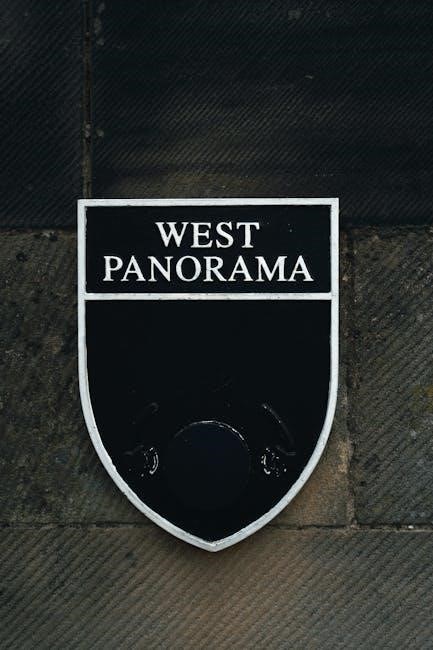Radiographic positioning is a critical aspect of diagnostic imaging‚ ensuring accuracy and patient safety. It involves precise patient placement to capture optimal images‚ guided by established techniques and resources like Merrills Atlas.
1.1 Overview of Radiographic Positioning
Radiographic positioning refers to the precise placement of the patient’s body to produce high-quality images for accurate diagnosis. It involves aligning the anatomical structure with the image receptor and central ray. Proper positioning ensures diagnostic accuracy‚ patient safety‚ and optimal image quality. Standard protocols guide positioning for various body regions‚ from skull to extremities; This fundamental process requires understanding anatomy‚ terminology‚ and technical factors to achieve consistent results. Resources like textbooks and clinical guidelines‚ such as Merrill’s Atlas‚ provide detailed reference for positioning techniques‚ aiding radiographers in delivering reliable outcomes.
1.2 Importance of Proper Positioning
Proper radiographic positioning is essential for ensuring diagnostic accuracy‚ patient safety‚ and optimal image quality. Correct alignment of the patient’s anatomy with the central ray and image receptor minimizes distortion and superimposition‚ allowing clinicians to make precise diagnoses. Improper positioning can lead to retakes‚ increasing radiation exposure and healthcare costs. Additionally‚ it enhances patient safety by reducing the need for repeat procedures. The radiographer’s skill in positioning directly impacts the quality of care‚ making it a cornerstone of effective imaging and patient management. Accurate positioning also aids in identifying anatomical variations and abnormalities‚ ensuring reliable diagnostic outcomes.
1.3 Historical Development of Positioning Guides
The development of radiographic positioning guides traces back to the early 20th century‚ following Wilhelm Roentgen’s discovery of X-rays. Early radiographers relied on trial and error‚ but the need for standardized techniques grew. The first formal positioning guides emerged‚ detailing patient placement and imaging parameters. Key resources like Merrill’s Atlas of Radiographic Positioning and Procedures became foundational‚ offering systematic approaches for various anatomical regions. Over time‚ advances in technology and imaging modalities led to updates and expansions of these guides. Today‚ positioning guides are essential for radiography education and practice‚ ensuring consistency and quality in diagnostic imaging.

Key Principles of Radiographic Positioning
Key principles of radiographic positioning emphasize accuracy‚ patient safety‚ and optimal image quality. Proper alignment‚ patient preparation‚ and adherence to standardized techniques guide radiographers in achieving diagnostic excellence.
2.1 Patient Positioning Terminology
Patient positioning terminology is essential for clear communication in radiography. Terms like anterior-posterior (AP)‚ lateral‚ and oblique describe the direction of the x-ray beam. Positions such as supine‚ prone‚ sitting‚ and standing standardize patient placement. Understanding these terms ensures consistency and accuracy in imaging. Synonyms like craniocaudal (head-to-tail) and caudo-cranial (tail-to-head) are also used. Proper terminology aids in achieving optimal image quality and minimizing retakes‚ ensuring patient safety and diagnostic clarity.
2.2 The Role of the Radiographer in Positioning
The radiographer plays a pivotal role in ensuring proper patient positioning‚ directly impacting image quality and diagnostic accuracy. They must communicate clearly‚ guide patients into correct poses‚ and adapt techniques for diverse anatomical variations. Radiographers ensure patient safety‚ minimizing discomfort and radiation exposure. Their expertise includes handling challenging cases‚ such as anxious or uncooperative patients‚ while maintaining precise positioning to capture essential diagnostic details. Effective positioning requires a deep understanding of anatomy‚ terminology‚ and technical factors‚ making the radiographer indispensable in producing clear‚ accurate images for medical evaluation.
2.3 Factors Influencing Positioning Decisions
Positioning decisions are influenced by patient condition‚ age‚ and anatomical variations. Radiographers adapt techniques for patients with limited mobility or pain‚ ensuring comfort and safety. Equipment capabilities‚ institutional protocols‚ and the radiographer’s expertise also guide decisions. Patient cooperation and ability to follow instructions are crucial. Contrast agents‚ the need for specialized views‚ and avoiding anatomical obstructions further shape positioning strategies. Each factor must be balanced to achieve optimal image quality while minimizing radiation exposure and patient discomfort‚ ensuring accurate diagnostic outcomes.

Positioning for Specific Body Regions
Positioning techniques vary by body region‚ requiring precise anatomical alignment for optimal image quality. Skull‚ spine‚ chest‚ and extremities each demand specific positioning to ensure clarity and patient safety.
3.1 Skull and Facial Bones
Positioning for skull and facial bones requires precise alignment to ensure clear visualization of anatomical structures. Common projections include occipito-frontal‚ lateral‚ and basal views. For occipito-frontal‚ the patient’s head is positioned so the midsagittal plane is perpendicular to the image receptor‚ with the petrous ridge at the floor of the orbit. Lateral views involve aligning the midsagittal plane parallel to the receptor‚ ensuring the petrous ridges are symmetric. Basal projections require the patient to extend their head back‚ preventing tracheal superimposition. Proper positioning ensures diagnostic accuracy‚ minimizing overlap of critical structures like sinuses and orbital cavities. Radiographers must carefully adjust angles and alignments to achieve optimal results.
3.2 Spinal Column
Positioning for the spinal column involves capturing accurate views of cervical‚ thoracic‚ and lumbar regions. For anteroposterior (AP) projections‚ the patient stands or sits upright‚ with the spine centered on the image receptor. Lateral views require the patient to side-bend‚ aligning the midsagittal plane with the receptor. Proper alignment ensures clear visualization of intervertebral spaces and facet joints. The chin should be extended‚ and the thorax centered on the central ray without rotation. Radiographers must ensure the spine is perpendicular to the receptor‚ avoiding distortion. This precise positioning aids in diagnosing fractures‚ degenerative changes‚ and spinal alignment issues‚ optimizing diagnostic accuracy and patient care.
3.3 Chest and Thoracic Cavity
Chest radiography is a fundamental diagnostic tool‚ capturing the thoracic cavity‚ lungs‚ and surrounding structures. Standard projections include posteroanterior (PA) and anteroposterior (AP) views‚ with lateral decubitus views used for specific conditions like pleural effusion. Patient positioning requires careful alignment‚ with the midsagittal plane centered on the image receptor. For PA views‚ the patient stands upright‚ arms raised‚ and fingers extended. Inspiration is crucial to ensure optimal lung expansion. The radiographer must avoid rotation and ensure the clavicles are projected below the lung apices. Proper positioning enhances diagnostic accuracy‚ minimizing anatomical overlap and providing clear visualization of the thoracic structures for effective assessment.
3.4 Upper Extremities
Positioning for upper extremities requires precise alignment to capture the shoulder‚ arm‚ forearm‚ wrist‚ and hand accurately. Common projections include anteroposterior (AP) and lateral views of the shoulder and humerus. For the elbow‚ flexion and extension views are essential to assess joint integrity. The wrist and hand are typically imaged in the PA and lateral projections‚ ensuring minimal overlap of bones. Proper patient positioning enhances image quality and diagnostic accuracy‚ allowing clear visualization of fractures or joint abnormalities; Immobilization techniques‚ such as using supports or sandbags‚ are often employed to maintain correct alignment and prevent movement during exposure.
3.5 Lower Extremities
Positioning for lower extremities focuses on capturing the hip‚ femur‚ knee‚ tibia-fibula‚ and ankle in standard projections. The hip is typically imaged in the anteroposterior (AP) and lateral views‚ ensuring the femoral neck and acetabulum are visible. The femur requires an AP projection with the leg extended and internally rotated. Weight-bearing views of the knee‚ such as the AP and lateral‚ are essential for assessing joint alignment and integrity. For the tibia-fibula‚ AP and lateral projections are used with the leg extended. Ankle imaging includes AP‚ lateral‚ and oblique views to evaluate fractures or degenerative changes. Proper alignment and immobilization are crucial for accurate diagnosis.
3.6 Pelvis and Hip
Positioning for the pelvis and hip involves capturing standard projections to assess fractures‚ degenerative changes‚ or congenital conditions. The anteroposterior (AP) view is obtained with the patient supine or upright‚ centering the pelvis to include both femoral heads and acetabulae. Weight-bearing views are essential for evaluating joint alignment and integrity. Lateral projections of the hip require the patient to position their side against the image receptor‚ ensuring the femoral neck and acetabulum are visible. Proper alignment and immobilization are critical to prevent movement artifacts and ensure diagnostic accuracy in radiographic imaging of the pelvis and hip.
3.7 Abdominal and Pelvic Regions
Positioning for abdominal and pelvic radiography requires careful alignment to visualize key structures. The kidneys‚ ureters‚ and bladder (KUB) view is a standard abdominal projection‚ obtained with the patient supine‚ knees slightly flexed‚ and arms extended. The central ray is directed perpendicular to the image receptor‚ centered at the umbilicus. For pelvic imaging‚ the anteroposterior (AP) view is taken with the patient supine or upright‚ ensuring the pubic symphysis is visible. Proper patient preparation‚ including the removal of artifacts‚ is essential. These views are critical for detecting conditions like kidney stones or structural abnormalities in the urinary tract and pelvic organs.

Technical Considerations in Radiographic Positioning
Technical considerations include contrast agent use‚ image receptor selection‚ and adapting techniques for patient conditions and age. Proper equipment and settings ensure optimal image quality and diagnostic accuracy.
4.1 Use of Contrast Agents
Contrast agents are substances used to enhance the visibility of internal structures in radiographic images. They work by absorbing or altering the X-ray beam‚ highlighting specific areas of interest. Common agents include barium sulfate for gastrointestinal imaging and iodine-based compounds for vascular studies. The choice of contrast agent depends on the procedure‚ patient condition‚ and desired diagnostic outcome. Proper administration and timing are critical to ensure safety and effectiveness. Adverse reactions‚ though rare‚ must be monitored‚ especially in sensitive populations. Contrast agents significantly improve image quality‚ aiding in accurate diagnoses and treatment planning.
4.2 Image Receptor and Grid Selection
The image receptor captures the radiographic image‚ while grids reduce scatter radiation‚ enhancing image quality. Digital receptors‚ including flat-panel detectors‚ offer high sensitivity and instant image availability. Grid selection depends on factors like patient size‚ anatomy‚ and desired image quality. Higher grid ratios (e.g.‚ 12:1) provide greater scatter reduction but may increase dose requirements. Proper alignment and positioning of the grid ensure optimal results. In digital imaging‚ grid usage may be adjusted based on software capabilities. Selecting the right receptor and grid combination is vital for balancing image quality and patient radiation exposure‚ ensuring diagnostic accuracy while maintaining safety standards.
4.3 Patient Condition and Age Considerations
Patient condition and age significantly influence radiographic positioning. For geriatric or frail patients‚ positioning must prioritize comfort and safety‚ minimizing strain on joints. Pediatric patients require specialized techniques to accommodate smaller anatomy and potential anxiety. Immobilization devices may be used to ensure proper alignment. Trauma cases demand careful handling to avoid exacerbating injuries. Contrast agents are often used to enhance visibility in complex conditions. Adjustments in technique and equipment‚ such as lower radiation doses for children‚ are essential. Radiographers must adapt their approach to meet individual needs‚ ensuring diagnostic accuracy while maintaining patient well-being and safety.

Safety in Radiographic Positioning
Safety in radiographic positioning involves radiation protection‚ proper equipment handling‚ and infection control. Techniques ensure patient well-being and adhere to guidelines‚ minimizing risks while optimizing image quality.
5.1 Radiation Safety Measures
Radiation safety measures are essential to minimize exposure risks for both patients and radiographers. The ALARA principle (As Low As Reasonably Achievable) guides dose reduction. Shielding‚ such as lead aprons and thyroid collars‚ protects sensitive areas. Proper positioning ensures radiation beams are directed only at the target anatomy‚ reducing scatter. Digital systems optimize dose monitoring‚ while regular equipment maintenance ensures accuracy. Radiographers must also educate patients on safety protocols and risks associated with radiation exposure‚ fostering a culture of safety and accountability in every imaging procedure.
5.2 Proper Use of Equipment
Proper use of radiographic equipment ensures optimal image quality and safety. Radiographers must correctly position and operate X-ray machines‚ image receptors‚ and accessories. Regular maintenance and calibration are crucial for accurate results. Using appropriate positioning tools‚ such as calipers and alignment lights‚ helps achieve precise patient placement. Adhering to manufacturer guidelines ensures equipment functions safely and effectively. Proper handling of image receptors and grids minimizes artifacts and repeat exposures. By following standardized protocols‚ radiographers can enhance diagnostic accuracy while maintaining patient and staff safety‚ ultimately contributing to high-quality imaging outcomes and efficient workflows in radiographic procedures.

5.3 Infection Control Practices
Infection control is vital in radiographic positioning to protect patients and staff. Proper hand hygiene‚ use of personal protective equipment (PPE)‚ and sterilization of equipment are essential. All surfaces and tools must be disinfected regularly. Patients should wear gowns and remove jewelry or clothing with metal parts. Radiographers should follow protocols for handling bodily fluids and contaminated materials. Maintaining a clean environment ensures safe procedures‚ reduces infection risks‚ and promotes a hygienic workspace. Adhering to these practices is critical for preventing the spread of pathogens and ensuring a safe imaging process.

Patient Preparation and Communication
Patient preparation involves removing artifacts‚ using gowns‚ and positioning correctly. Effective communication ensures understanding‚ reducing anxiety‚ and promoting cooperation. Clear explanations and empathy enhance the imaging experience.
6.1 Preparing the Patient for Imaging
Preparing the patient for imaging involves removing artifacts like jewelry or clothing with metal parts. Patients are typically dressed in hospital gowns to avoid interference. Clear explanations of the procedure are provided to reduce anxiety. Positioning instructions are given to ensure proper alignment with the image receptor. Patients are advised to remain still and hold their breath when necessary to prevent motion artifacts. Proper preparation ensures diagnostic accuracy and patient safety‚ fostering a cooperative environment for optimal imaging outcomes.
6.2 Communicating with the Patient
Effective communication is essential for successful radiographic positioning. Clear‚ simple explanations of the procedure reduce patient anxiety and ensure cooperation. Patients should be informed about the importance of remaining still and holding their breath during imaging. Radiographers should use visual aids or demonstrations to guide positioning. Active listening and empathy help address patient concerns‚ fostering trust. Providing reassurance about safety and the necessity of the procedure encourages compliance. Non-verbal cues‚ such as gestures‚ can also aid understanding. Clear communication ensures accurate imaging and a positive patient experience‚ making the process efficient and stress-free for both parties.
6.3 Handling Anxious or Uncooperative Patients
Handling anxious or uncooperative patients requires empathy‚ patience‚ and clear communication. Radiographers should create a calming environment‚ explaining procedures in simple terms to reduce fear. Encourage deep breathing to relax the patient. Positive reinforcement and reassurance can build trust. For uncooperative patients‚ demonstrate positioning first and offer breaks if needed. Non-verbal cues‚ such as gentle gestures‚ can also help. Addressing concerns promptly and providing emotional support fosters cooperation. Stay patient and flexible‚ adapting techniques to meet individual needs. Effective management ensures both patient comfort and successful imaging outcomes‚ even in challenging situations.

Advanced Imaging Techniques
Advanced imaging techniques like fluoroscopy‚ CT‚ and MRI provide detailed‚ real-time insights‚ enhancing diagnostic accuracy. These technologies integrate with positioning guides to optimize patient outcomes and image quality.
7.1 Fluoroscopy and Real-Time Imaging
Fluoroscopy provides real-time X-ray imaging‚ enabling dynamic visualization of internal structures. It enhances diagnostic accuracy in procedures like swallowing studies or joint injections. Radiographers use fluoroscopy to guide precise patient positioning and needle placements‚ reducing the need for repeat exposures. This technique is particularly useful for observing movement and function‚ offering insights unavailable through static images. Proper patient preparation and breath-holding techniques are essential to ensure clear imaging. Fluoroscopy integrates seamlessly with modern imaging systems‚ improving procedural efficiency and patient outcomes while maintaining radiation safety protocols.
7.2 Computed Tomography (CT) Positioning
CT positioning requires precise alignment to ensure optimal image quality and patient safety. Radiographers must carefully position patients to accommodate the gantry’s movement and minimize radiation exposure. For thoracic imaging‚ patients are positioned supine with arms raised‚ while abdominal scans may require feet-first positioning. Immobilization devices are used to maintain stability‚ especially for pediatric or uncooperative patients. Proper alignment of the laser grid with anatomical landmarks ensures accurate slice acquisition. Breathing instructions‚ such as breath-holding‚ are crucial for reducing motion artifacts. The radiographer’s attention to detail in positioning directly impacts diagnostic accuracy and patient outcomes in CT imaging.
7.3 Magnetic Resonance Imaging (MRI) Positioning
MRI positioning demands precise patient alignment due to the strong magnetic field and need for clear image resolution. Patients must remove ferromagnetic objects and may require specific coils for optimal imaging. Positioning varies by body region: head scans often use a head coil‚ while spinal exams require precise vertebral alignment. The laser grid aids in centering anatomical structures. Immobilization straps or cushions are used to prevent movement. For claustrophobic patients‚ open MRI systems or sedation may be employed. Breathing techniques are sometimes instructed to reduce motion artifacts. Proper positioning ensures image clarity and diagnostic value‚ prioritizing patient safety and procedural success.

Troubleshooting and Problem Solving
Troubleshooting in radiographic positioning involves identifying common errors like patient movement or incorrect angles. Adjustments for anatomic variations ensure accurate imaging‚ requiring skill and attention to detail.
8.1 Common Positioning Errors
Common positioning errors include improper patient alignment‚ inadequate coverage of the anatomic region‚ and incorrect use of equipment. These errors can lead to suboptimal image quality‚ potentially causing misdiagnosis. Overlapping structures‚ poor contrast‚ and motion artifacts are frequent issues. Radiographers must ensure proper patient preparation‚ such as removing artifacts and positioning the patient correctly. Technical adjustments‚ like adjusting the central ray or image receptor‚ are often necessary. Awareness of these errors and their solutions is crucial for producing diagnostic-quality images and ensuring accurate interpretations. Continuous training and adherence to established guidelines help minimize these mistakes.
8.2 Adjusting for Anatomic Variations
Radiographers must account for anatomic variations‚ such as unusual bone structures or pathologies‚ to ensure accurate imaging. Adjustments may involve modifying patient positioning or using specialized techniques. For example‚ fluoroscopy allows real-time adjustments to capture optimal views. Understanding common variations‚ like spinal curvatures or joint anomalies‚ is essential. Proper use of contrast agents and precise alignment of the central ray can help overcome these challenges. Regular training and experience enhance the ability to adapt positioning strategies effectively‚ ensuring diagnostic-quality images even in complex cases.
8.3 Managing Challenging Patients
Managing challenging patients requires effective communication and empathy. Radiographers should explain procedures clearly to reduce anxiety and ensure cooperation. Techniques like deep breathing can help calm nervous patients. For uncooperative individuals‚ gentle yet firm guidance may be necessary. Immobilization devices or supportive tools can aid in maintaining proper positioning. Safety is paramount‚ especially for patients with mobility issues. Building trust through clear instructions and reassurance fosters a positive experience. Continuous assessment of the patient’s condition ensures adjustments are made to accommodate their needs while achieving diagnostic-quality images.

Case Studies and Practical Applications
Case studies demonstrate practical applications of radiographic positioning‚ showcasing routine and specialized procedures. Real-life examples highlight effective techniques for diverse patient scenarios‚ enhancing diagnostic accuracy and clinical outcomes.
9.1 Routine and Specialized Procedures
Routine and specialized radiographic procedures are essential for accurate diagnosis. Routine procedures‚ like chest X-rays‚ are standardized‚ while specialized ones‚ such as CT scans‚ require tailored positioning. These procedures ensure optimal image quality‚ minimizing retakes and radiation exposure. Radiographers use resources like Merrills Atlas to guide positioning for diverse anatomical regions. Proper patient preparation‚ including removing artifacts and positioning aids‚ is crucial. Techniques vary based on the body region‚ ensuring diagnostic accuracy. Standardization in routine procedures and adaptability in specialized cases enhance patient care and outcomes‚ making radiographic positioning a cornerstone of modern diagnostics.
9.2 Emergency and Trauma Imaging
In emergency and trauma situations‚ radiographic positioning must be rapid yet precise to assess injuries. Techniques prioritize patient stability and safety‚ often using anteroposterior (AP) projections for quick evaluation. Immobilization devices‚ such as splints or sandbags‚ are employed to maintain alignment without causing further harm. Clear communication and gentle handling are essential‚ especially for uncooperative or critically injured patients. The goal is to obtain diagnostic-quality images efficiently‚ ensuring minimal movement to avoid blur. Radiographers must adapt standard protocols to accommodate life-threatening conditions‚ balancing speed with accuracy to aid timely treatment decisions.
9.3 Pediatric and Geriatric Considerations
Pediatric and geriatric patients require specialized radiographic positioning techniques due to their unique anatomical and physiological needs. For children‚ minimizing fear and discomfort is crucial‚ often involving gentle immobilization devices and clear communication. Geriatric patients may need adjustments for mobility or cognitive challenges‚ ensuring dignity and safety. Positioning must account for developmental stages in children and potential degenerative conditions in the elderly. Radiation dose reduction is prioritized for both groups‚ using size-appropriate techniques to ensure diagnostic quality while minimizing exposure. Tailored approaches enhance patient cooperation and image accuracy‚ addressing the distinct requirements of these vulnerable populations.
Radiographic positioning continues to evolve‚ driven by advancing technology and the need for precise‚ patient-centered imaging. Continuous learning and adaptation are essential for professionals to stay current and deliver optimal outcomes.
10.1 Evolution of Positioning Techniques
Radiographic positioning techniques have evolved significantly since Roentgen’s discovery of X-rays. Early methods were rudimentary‚ focusing on basic alignments‚ but advancements in technology and understanding of anatomy led to standardized guides. The development of fluoroscopy and cross-sectional imaging modalities like CT and MRI revolutionized positioning‚ enabling real-time adjustments and precise patient alignment. Modern techniques emphasize patient-centered care‚ integrating digital tools and AI for enhanced accuracy. Continuous updates in imaging technologies and evidence-based practices ensure that radiographic positioning remains dynamic‚ adapting to improve diagnostic outcomes and patient safety.
10.2 Impact of Technology on Positioning
Technology has transformed radiographic positioning‚ enhancing accuracy and efficiency. Digital imaging systems and AI algorithms optimize patient alignment‚ reducing radiation exposure. Advanced tools like 3D reconstruction and fluoroscopy enable real-time adjustments‚ improving diagnostic outcomes. Automated positioning guides and robotic systems streamline workflows‚ minimizing errors. These innovations allow for personalized patient care‚ accommodating diverse anatomical variations. However‚ they also require continuous training for radiographers to master new techniques. The integration of technology ensures safer‚ more precise imaging‚ revolutionizing the field and setting new standards for radiographic positioning in modern healthcare.
10.3 Continuous Learning and Professional Development
Continuous learning is essential for radiographers to stay updated with advancements in radiographic positioning. The field evolves rapidly‚ with new technologies and techniques emerging regularly. Radiographers must engage in ongoing education‚ workshops‚ and certifications to maintain competency. Professional development ensures they adapt to evidence-based practices and improve patient outcomes. Resources like Merrills Atlas and industry journals provide valuable insights. Active participation in professional organizations and conferences fosters networking and knowledge sharing. Commitment to lifelong learning enhances skill mastery‚ ensuring radiographers deliver high-quality‚ patient-centered care while advancing their careers in this dynamic field.

No Responses